|
|
Welcome to my travel log! You will find here a lot more than in the travel reports, stripped from political correctness. Enjoy! 
Mar 30, 2006 02:00 PM Ejisu - no spirit left...
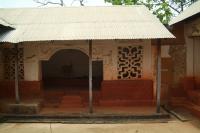 The real reason I went to the Ashanti region was to visit the fetish shrines called Abosomfie. First of all, they represent the surviving examples of traditional Ashanti architecture, characterised by a tall thin house with steep thatched roof, rising at an angle exceeding sixty degrees. Stretching ones imagination, one could visualise what Kumasi must have looked like before it was completely destroyed by the British in 1874.
The real reason I went to the Ashanti region was to visit the fetish shrines called Abosomfie. First of all, they represent the surviving examples of traditional Ashanti architecture, characterised by a tall thin house with steep thatched roof, rising at an angle exceeding sixty degrees. Stretching ones imagination, one could visualise what Kumasi must have looked like before it was completely destroyed by the British in 1874.
Second of all, only there could one see a piece of disappearing Ashanti tradition or belief in media and ghosts. Actually, to be exact there is one supreme god Nyame, who speaks through a lesser deity called Obosom, who in turn, must find a medium in order to speak to people. That medium is a priest called Okomfo, who works in a shrine to give advice to people who ask for it.
A shrine, as I figured, was not the quadrangular courtyard but a bell or something similar, which can travel from one building to another, and this way creating a meeting point for the people.
This is what I found in Ejisu, or rather Jachie village, where the caretaker of the Aduko Jachie shrine told me that the Okomfo took the shrine with him and performed elsewhere. This was the first Obosomfie (singular from Abosomfie) that I visited. I specifically chose Friday to see it, as I read that I would be able to see the Okomfo. And I did not.
Nevertheless I had to bring a bottle of Schnapps with me for the Obosom. The old lady caretaker, who opened the courtyard for me was very cheeky. She did not want to accept the locally produced Schnapps and demanded a foreign one, which was three times more expensive. I did not want to offend her, and since Philip knew nothing about the culture, I could not argue. I had to give her money equivalent of the foreign Schnapps!
The temple in Jachie was however interesting and kept in a reasonably good condition, although it was not elaborately decorated as the literature suggested. The lady told me that the villagers hoped one day someone would bring back the shrine.
|
Mar 29, 2006 02:00 PM Kumasi - impossible traffic
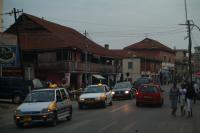 The Ashanti capital, along with a few small villages in the area, were the only destinations in the Ghana’s interior that survived the many iterations to my itinerary.
The Ashanti capital, along with a few small villages in the area, were the only destinations in the Ghana’s interior that survived the many iterations to my itinerary.
And when I got to Kumasi, I was somewhat disappointed with it. It was ugly and not a single bit reminded of its past glory, when it was considered the most beautiful town in West Africa.
Well, although there was nothing to do there and the traffic was horrific, it was not too bad. There was some logic to it and navigation of the town was not excessively complex. The streets were reasonably clean and only the ugly buildings were making a nightmare background.
Kumasi had one particular feature, which I can describe as gripping, and even amusing. A few roundabouts in town were decorated by weirdest and ultimately African statues and sculptures. These were so interesting or otherwise important that tourist maps used them as orientation points. Usually they represented former kings and chiefs or near-abstract African fauna and flora, and hence did decorate this almost hideous town.
I must not forget to mention a living legend of Kumasi. It is a restaurant and cafe. Its named Vic Baboo’s Cafe and is perhaps the best eatery in Ghana. It is most definitely the best value food serving place in West Africa. It was so good, that my driver Philip was raving about it for the next two weeks. He did not always approve my restaurant choice complaining about the price and poor choice of African dishes in the menu for him to select from. But this one in Kumasi blew him off the floor!
The menu would take a few hours to study. This is how extensive it was, and for two US dollars one could choose from at least thirty dishes.
I found a fort in Kumasi as well! Yes! I did not like it too much though. It was converted into a military museum and a few pieces of war machinery was exposed at the front of the main building, right in the street. The walls of the fort were painted in a funny shade of red colour.
I was so appalled with its view that I decided not to enter. Maybe it is a paradox, but I am not fond of military tools and installations. I am totally into fortified buildings and structures, and only defence architecture fascinates me. And I can only explain it by saying that building a fortified city meant protection and not aggression!
|
Mar 29, 2006 02:00 PM Shama - Fort San Sebastian
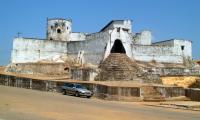 I was proceeding to my total eclipse stationing base in Busua, and there were only two forts on the way that I wanted to visit. This required me, and my driver, to stop in Shama first. Well, Philip missed the junction again. I told him that I would need to stop in Shama on the way back.
I was proceeding to my total eclipse stationing base in Busua, and there were only two forts on the way that I wanted to visit. This required me, and my driver, to stop in Shama first. Well, Philip missed the junction again. I told him that I would need to stop in Shama on the way back.
Built in 1523, Fort San Sebastian was the third oldest fortress in Ghana. The Portuguese, as usual, started working on it for only the fort to be captured by the Dutch, as usual...
When I eventually got there, I found the fortress in an excellent state. It was used as the main post office for Shama, and its position near the town’s main square was very convenient and great.
When I was visiting, the caretaker of the fort was not around, and the woman, who could not be possibly more eager to invite me inside (she was screaming across half the town!) refused to give me receipt for the entrance fee. Philip told me about this crooky practice, so I argued with the woman that if she was not going to give me a receipt I was simply not going to pay anything. She claimed that people would tell the caretaker that foreigners visited the fort and he would expect her to give up the money. I told her that she should have no problem explaining what happened. Since the drawer with the receipt was allegedly locked, the tourists refused to pay the entry fee in order to avoid corruption, or rather, people pocketing the money. I said I could give her my statement why I refused to give her any money.
I took a few photographs in side and outside the stronghold and since I was rather impressed with it, I decided to ease the woman’s nerves and paid her something, explicitly instructing her what to say to the caretaker upon his return, so she would not have such a problem in the future.
The fort was empty. Apart from the post office taking up one of the rooms downstairs, the upper part of the fort, offering interesting views and cosy rooms, was disused. I did not have many ideas how this could be utilised. Since the post office was there, for security reasons, little could be done to the rest of the fort. Apart from a more meaningful museum, nothing else would really work. Shama was not particularly interesting for any other reason, so a guest house or a restaurant would not make much sense.
The Gold Coast had many European visitors trying to control it, the Swedes, the Dutch, the Portuguese, the Danes, the French, the British. They all must have brought their currencies with them. I think a museum with the money would attract many. And security designed for the post office should already be appropriate.
There was nothing else of interest in Shama, and I have no more to say about it.
|
Mar 28, 2006 02:00 PM Nzulezu - a village on stilts
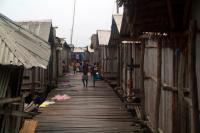 When I first was planning to see Nzulezu, and I can definitely trace it back to the year of 1998, I never knew that it would require me to get very wet even before I was to step into a tiny canoe.
When I first was planning to see Nzulezu, and I can definitely trace it back to the year of 1998, I never knew that it would require me to get very wet even before I was to step into a tiny canoe.
The rainy season was late and the Lake Amansuri was partially dry, so I could take my car, reluctantly I might add, to the water’s edge. When the lake is full the boat trip takes ninety minutes. I was told that my trip was going to take half that.
I will not go into too much detail about the slight accident the car had there and that several men had to lift it from the mud hole. Literally. I will move directly to the tiny canoe. I had to take my boots off and walk in the lake for about fifteen minutes. I was not prepared for that. I had no idea what I was walking on and what kind of creatures might have lived in the water. Well, I remained calm, as this was not my first time like that at all. I already famously did that in Mozambique.
The canoe Dominic took, was not even his. And when it was deep enough to come inside it, it took about ten minutes to realise that it was leaking. He had to jump inside the lake again to bring another one. Slightly larger one, too.
The trip through the thick and lush vegetation before I got to the actual lake, was fun. Dominic was, like a real teacher, patiently answering all questions.
The village, which was really just two rows of wooden and reed houses built on stilts along two elevated streets was quiet. People were going about their business and paid little attention to my presence. Women were cooking, weaving, mending clothes, washing up, making laundry, or relaxing. Boys were playing football at a very small pitch made of reed cane, and young lads were just hanging around doing absolutely nothing. They paid the most attention to me being there.
I later found out that they were simply watching their women. The Nzulezu women were reserved exclusively for the Nzulezu men. No exceptions were allowed unless the woman chose to abandon the village and never come back.
The village was not the cleanest one. That was surprising since being built on water, cleaning should be dead easy.
Yet, a lot rubbish lied around between the houses. Justice, a boy I met in Busua and whom I gave a lift to Nzulezu, grabbed one of the young guys (I think he might have chosen one with largest muscles - a leader?) and explained to him that it was important to keep the place tidy. Not only for themselves but also for the tourists.
He said that the village had a few meetings in this matter yet it remained unresolved for years. This young muscle guy proved to be a clever one as well. He said that the truth was like a shoe everyone had their size. And you know what? I am going to leave it without comment.
Visiting Nzulezu was a great experience and fun, as expected. It was very different to everything else I was doing in Ghana by that time. The village was not a fort. The houses, although hard to access, were every bit fragile and had to be rebuilt every eight years. To get there I was travelling slowly in a dingy canoe, had to get seriously wet before I actually saw anything, opposed to speeding comfortably in a large and fully air-conditioned estate two-litre-engine car.
|
Mar 28, 2006 02:00 PM Beyin - small fort, Fort Apollonia
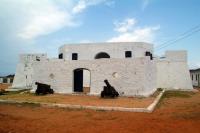 The small town of Beyin was so close to the border with Ivory Coast, that made me disbelieve how far I went. It was far enough that the good coastal road ended and turned in to a rather bad gravel track. Bad enough for Philip to freak out a little and loose confidence in how fast he could drive the car on that regularly uneven surface. He drove too slow, making the car shake like thick custard pudding.
The small town of Beyin was so close to the border with Ivory Coast, that made me disbelieve how far I went. It was far enough that the good coastal road ended and turned in to a rather bad gravel track. Bad enough for Philip to freak out a little and loose confidence in how fast he could drive the car on that regularly uneven surface. He drove too slow, making the car shake like thick custard pudding.
There were two reason why I went so far. The last fort along the western stretch of Ghana’s cost, Fort Apollonia, and the tourist office, which I needed to visit if I wanted to see the stilt village of Nzulezu.
The small but exceptionally strong fort was the very last one constructed by the British in 1770. It served as a slave trading post only for thirty or so years until slavery was permanently outlawed by the United Kingdom.
When I visited the fort, there was no caretaker and the door was open. The fortress was turned into a resthouse and I could see there were a few extremely dirty beds available in very small rooms. There was also a European style toilet there, but it looked like it was never used and the dirt continued accumulating since the day the fort was restored in the 1950’s.
When I think about this fort, I still cannot believe how far it was and how isolated it must have been. Other forts, particularly those in Anomabu, Moree, Cape Coast, Elmina, Komenda and Shama were so close to one another that one could almost see one from the next. The Fort Apollonia in Beyin looked so lonely and remote that it felt like there was nothing there further west.
The tourist board, which I needed to visit was located in a nice garden in a pretty colonial building at the western edge of the town.
I thought it was located elsewhere, and I wandered from the fort in a completely wrong direction. To be fair, I asked two young local guys about the office, but they did not speak English! The fort caretaker caught up with me in the middle of the town later on and he was so disappointed to hear that I had already seen the fort, and that it was very unlikely any subsequent donation was going to land on his hands. However, he was kind enough to direct me to the building I was looking for.
The guys, who worked at the tourist office were taking a break. I was not surprised and I was definitely not disappointed. Again.
They did wake up and issued me the necessary tickets for Nzulezu when I stepped into the building. The officer was not particularly informative or helpful. He felt nevertheless obliged to tell me that I was better off taking my car into the dried up part of the lake to shorten my canoe trip.
I even picked up my canoe man, Dominic, or otherwise known as Mr Kofi (since he was born on Friday), right at the office’s doorstep. He had his paddles with him. He was wearing the London Underground blue checkered shirt. I also found out that he was a teacher at the local school in Beyin. He taught English, if I remember well, and was in his mid twenties, and he wore the blue London Underground shirt!
|
Mar 28, 2006 02:00 PM Busua - Total Eclipse of the Sun
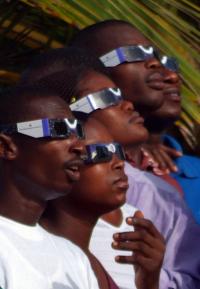 The second dancing group that arrived in the morning for the actual eclipse extravaganza and television broadcast, were so much better. I cannot remember the name of the group, but I know that they came from the town of Mankessim (close to Fort Amsterdam). At least four guys were very good and three girls - pretty and talented.
The second dancing group that arrived in the morning for the actual eclipse extravaganza and television broadcast, were so much better. I cannot remember the name of the group, but I know that they came from the town of Mankessim (close to Fort Amsterdam). At least four guys were very good and three girls - pretty and talented.
They were dancing and dancing. Their programme lasted more than three hours and where they took all this energy from, I have no idea. Although it was morning, the day was hot and their routines were not from this planet!
The very event I came for, Total Eclipse, arrived finally just after 9 o’clock in the morning. Weather made me very nervous several times that morning. The overcast was terrible and gave a hazy look of the sky. Many white and grey clouds wandered around the sky occasionally covering up the sun. I was pissed. The television crew was however very confident and everything was going just too well. Boys and girls kept singing and dancing and all was being televised live for the entire nation.
And of course, just before the totality, the sky cleared reasonably well. It was free of clouds, but a slight haze remained. I walked away from the the television crew and the crowd that gathered around so I could be on my own enjoying it fully and undisturbed.
It had been four years since I saw my last total eclipse (Namibia, 4 December 2002) and I was beautifully reminded why I kept chasing them. The phenomenon was divine. It was totally wonderful. It lasted longer than the other two total eclipses I saw, and I had time to stand back, lower my camera and enjoy this spectacular and unforgettable occurrence.
I told everyone on my way to Busua what this eclipse would be like. Many of them did not believe me. I gave them instructions what to do. The authorities managed to warn everyone about the risks associated with unsecured viewing of the partial eclipse that many people got paranoid. I had to explain, particularly to my boys of Elmina, that to view the totality was safe and they definitely should take a moment and enjoy the eclipse.
I told them about the chickens that were going to go to sleep hiding their heads under their wings, and yet I was on a beach myself and could not witness napping chickens. Had I gone to the village itself, I would have. Well, it was not that important to me, anyway.
Having seen my first annular eclipse in Libya a few months back (3 October 2005) and then this total eclipse in Ghana, I realised that I was making a mistake. I was planing my travels in order to see both annular and total eclipses of the sun and I should definitely be skipping the annular ones. The total eclipses are so much more spectacular. They are incomparable!
The supremacy of the total eclipse over the annular one is that the annular eclipse never results in the sky getting dark. It can never be observed with a naked eye either, and taking picture of it requires putting on silly filters. That is definitely not fun at all.
So, I decided to change my eclipse travel planning strategy and only chase the total eclipses. This obviously will give me more flexibility with the choice of the places to visit and the sequence I would be going there. Well, at least I knew that my next eclipse destination was not going to be Suriname after all, but China or Russia on 1 August 2008, and Siberia to be more specific, I guess.
Anyway, I have to say that I could have been very lucky with weather in Ghana. Already the embassy of Ghana and the honorary consul to Benin in London warned me that since I was going at the beginning of the rainy season and I was risking it. They told me that I should have gone to Libya or Egypt for it. I hated that they told me that. I was nervous all the time, otherwise I would have been happily unaware of the risks.
Well, people on the Busua beach looked very happy with their eclipse shades on their noses. It was a big event for them, too.
Many stayed on the beach after the totality passed and singing and dancing continued for about an hour. As they stopped, I decided to move on and see more of the Ghanaian coast before I was about to head up north, to the Ashanti region.
|
Mar 27, 2006 02:00 PM Axim - Fort Sao Antonio
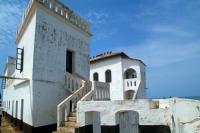 The not very pretty town of Axim had enjoyed the status of the busiest gold harbour along the Gold Coast. Actually it once was the busiest trading post of West Africa’s Atlantic coast. It started with gold, but Axim was also a large timber and cotton trading centre later on.
The not very pretty town of Axim had enjoyed the status of the busiest gold harbour along the Gold Coast. Actually it once was the busiest trading post of West Africa’s Atlantic coast. It started with gold, but Axim was also a large timber and cotton trading centre later on.
Such an important, in the past, town did not have much to offer when I visited. It was extremely significant though, because the fort located there, until recently still used as a government building, is Ghana’s second oldest.
The work on Fort Sao Antonio of Axim commenced by the Portuguese probably in 1515, and although Elmina dates back to 1492, it was rebuilt and changed so many times, that actually makes Fort Sao Antonio the oldest original structure in Ghana. Of course there were a few modifications made by the Dutch and later by the British, the bastions remained unchanged since the day of their construction. The fort, for its grandeur, is often called the Axim Castle. It was extremely impressive, I have to admit.
I would rank the fort in Axim along with the Elmina Castle, Cape Coast Castle and Fort William of Anomabu as amongst the most spectacular ones. The building inside the triangular wall was seriously attractive. It was not a single structure, or at least it looked like it was not. For example, from the governor’s bedroom situated in one of the towers, it was only possible to move to governor’s office in the other tower, by leaving the building. Well, the governor could walk over the roof, but he would still be leaving the building!
I particularly loved the front building, overlooking the ocean and the numerous little rocky islets, which formed a natural defence for the fort. Steep stairs were leading to the front door. It was so spooky how exposed the facade was. One could actually jump from the stairs over the main wall directly down to the ocean.
One of the islets worked as a station for the trade vessels, including slave ships. There is still a tunnel under the ocean, leading from the fort to the island. Some of it collapsed sadly, and it is no longer in use.
The young guide, Thomas, took his job very seriously. He remained controllably good humoured, professional and knew enough about the place to conduct the tour for an hour or so.
The bar, right west of the fort was fabulous. It was a rectangular courtyard with one side open towards the beach and the three with seating under small roofs. The bar had peculiar portraits hung around. One of them was of Bob Marley. It was so bad, that had it not been signed ‘Bob Marley’, I would have never guessed it! If I could, I would have stayed in the bar for dinner, this is how great this place was.
The prices were totally reasonable, the malt drink was appropriately cold and the food menu intriguing. There was plenty of shade there, the view of the beach was fine and it did not smell too badly, and even the front building of the fort was visible.
|
Mar 27, 2006 02:00 PM Princes Town - German fort and a perfect beach
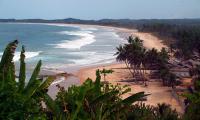 On my list of stronghold along the coast, there were still three other, one of which was Fort Gross Friedrichsburg, a rare German one dating to 1682. It was near the unattractive township of Princes Town, which boasted a marvellous beach.
On my list of stronghold along the coast, there were still three other, one of which was Fort Gross Friedrichsburg, a rare German one dating to 1682. It was near the unattractive township of Princes Town, which boasted a marvellous beach.
I did not like this fort. It was restored to become a resthouse and and when I visited it was occupied by a group of travelling students, who behaved rather suspiciously.
I did the tour around this fort as quickly as possible. The bastions looked realistically like a fortress, but the houses inside looked like regular German village houses. Architecturally, it was possibly the least appealing fortified structure in West Africa.
The beach under the fort was wide, clean and inviting. Like anywhere in Ghana, swimming in the ocean was tricky there, because of strong currents and large, mighty waves. I guess there was a reason for those students to come to Princes Town. Beside the beach, I personally did not see any other reason.
Uh, I almost forgot about the bats. In the Gothic-like arched ceilings of the fort’s dungeons several dozens of nice bats lived.
|
Mar 26, 2006 02:00 PM Butre - small fort, left to itself
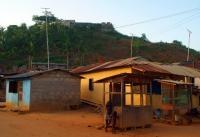 Butre and its ruined Fort Batenstein were quite well sign posted from the main road but that sign for Butre over there was the only one in Ghana. The only one and just too many crossroads. I got lost.
Butre and its ruined Fort Batenstein were quite well sign posted from the main road but that sign for Butre over there was the only one in Ghana. The only one and just too many crossroads. I got lost.
I thought I should be going south, and I was wrong. I should have been going west, after branching too far east first. I only realised that after driving twenty minutes in a wrong direction through, what I can only call, middle of nowhere.
Silly me, I had quite an accurate map with me, and had followed it I would have not wasted so much time heading in a wrong direction! Philip had to ask a person passing by on a moped for directions. The moped guy was ultimately polite and friendly and gave the most accurate and detailed directions I have ever heard from anyone. He told us about the two small villages we would be passing through and the bends and crossroads.
Butre was a hole! Sadly, of course. The village was a collection of poor huts, a small green church, a football pitch.
The Dutch fort, built in 1656 (on the photograph below), was ruined and almost forgotten. It was superbly looming from a steep hill overgrown with a collection of various vegetation. It looked quite large and had a great potential. It was much larger than the exquisitely restored fortress in Dixcove, however since Butre was such an ugly place, Ghana’s tourist board had been making no plans for the fort. And I know that from the proverbial horse’s mouth - the minister of tourism.
I could have stayed a little longer to check this place out a little more thoroughly, but it was getting dark and, to be honest, I was not exactly thrilled to do so. So I went back to my hotel in Busua.
|
Mar 26, 2006 02:00 PM Dixcove - Fort Metal Cross
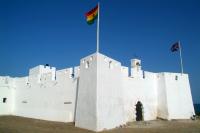 The pretty Fort Metal Cross in Dixcove was built by the British in 1692 and it was definitely the whitest and most glistering fortified building in Ghana that I saw.
The pretty Fort Metal Cross in Dixcove was built by the British in 1692 and it was definitely the whitest and most glistering fortified building in Ghana that I saw.
It was very easy to find - on the hill overlooking a semicircular fishing harbour. I could not believe how fresh and new it looked. It even had two flags raised - the Ghanaian and the Union Jack of the United Kingdom. I thought it was great, but none of the flags existed at the time when the fort was built.
The state of Ghana did not exist and the Union Jack was only introduced in 1707, when the kingdoms of England and Scotland were united under the Act of Union (called like that by the English) or the Treaty of Union (as it was called by the Scots).
Well, never mind. There were no signs of life around the fort and it was not obviously clear that one could come inside to visit it. I did not dear knocking on the door.
I cannot explain this but I felt Dixcove had a great atmosphere. It was a small village but it looked very nice and organised. The streets were narrow but all led to the harbour. There were also a few grand colonial buildings, which added that extra spice to the place.
The beach, right by the harbour, was busy with, as usual, with the fishermen mending their nets. One of the boats was being repainted and the owner was very surprised to see me. He actually asked me where I was going. I am not sure why he cared. Should not he be busy with his painting rather than making silly comments about me?
From there I took a great picture of the fort and the harbour. That was the very reason why I ventured between the fishing boats.
Dixcove, although small, had unique charm. No other place in Ghana I saw had it. The beach was rather awful and there was no place to relax on it. I mean the immediate beach in the town. There were superb beaches around, and all were easily accessible. Yet, Dixcove had no hotel. Someone told me that rooms could be available at the fort but I was unable to confirm that.
|
Page:
 69 70 71 72 73 74 75 76 77 78 79
69 70 71 72 73 74 75 76 77 78 79

|
|
|
